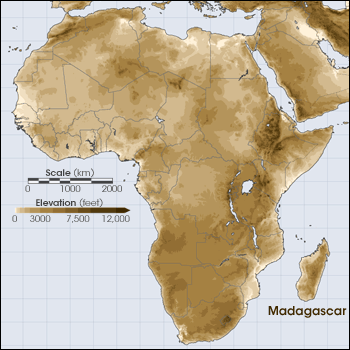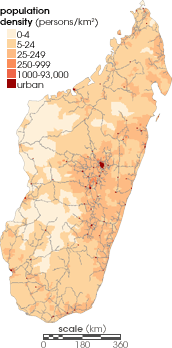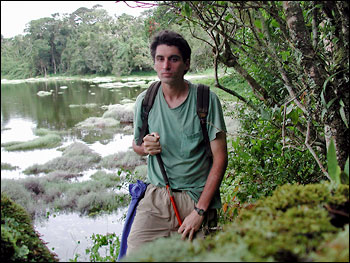

 |
 |
||
 |
“We can’t save all forests,” says Chris Raxworthy matter-of-factly. “Let’s say, hypothetically, that we could save 10 percent. We have to decide: What do we set aside? What do we let be destroyed?” He could be talking about the fate of forests anywhere in the world, but at the moment, the Curator-in-Charge of the Herpetology Department (amphibians and reptiles) at the American Museum of Natural History in New York is specifically talking about Madagascar, a large island off the southeast coast of Africa. |
||

In some other part of the world, it might be easier to identify the home of the rarest, most threatened creatures, or the plants most worth saving. But Madagascar is an island where the rare is commonplace. Separated from all other landmasses for 88 million years, a mind-boggling diversity of life forms evolved in isolation in Madagascar’s diverse topographic and climatic regions. This fourth-largest island in the world has one of the highest rates of unique species on the planet: 90 percent of its reptiles, 80 percent of its plants, and 46 percent of its birds are found nowhere else on Earth. Some individual mountain tops in Madagascar are home to as many as 200 species of plants found nowhere but that mountain! |
Madagascar separated from the southeast coast of Africa more than 80 million years ago. Its isolation, large size, and wide range of climatic and topographic features fostered the evolution of an extraordinary variety of species, giving Madagascar one of the highest concentrations of unique species on Earth. (Map by Robert Simmon) |
||
 |
|||
Raxworthy has been working for the past 18 years to describe what species live where on Madagascar, what species have already been lost, and what species can still be saved. Unfortunately, the clock of extinction is ticking rapidly away. The island’s population of about 17 million people is growing at 3 percent per year. As the growing population presses on the natural resources of the island, habitat and species are vanishing. Although scientists disagree about how much of the island was originally forested and how much has been lost, “It’s clear that over vast areas of the island, whatever natural landscape once existed is now gone,” says Raxworthy. Who knows how many species of plants like the rosy periwinkle—discovered on Madagascar and currently the key treatment for childhood leukemia and Hodgkin’s disease—have already gone extinct? The Cradle of ChameleonsSince 1985, Raxworthy has been exploring Madagascar, documenting and describing its reptiles and amphibians. His special fondness is for chameleons, those shade-shifting, intricately camouflaged lizards that can change color in response to environmental or behavioral influences. Since the oldest lineages of chameleons are all from Madagascar, scientists believe they evolved on the island and spread out from there. A backyard naturalist since he was a kid, Raxworthy joined his first field expedition, a trip to Morocco, during his first year of college. By his third year, he graduated from tag-along to expedition leader, and he knew exactly where he wanted to go: Madagascar—the cradle of chameleons. Raxworthy had been imagining that trip since he was a teenager, when books he read about the island caused Madagascar to stick in his imagination. |
Plants and animals unique to Madagascar include the Rosy Periwinkle (Vinca rosea) the Didereaceae family of cactus-like plants, the Black Lemur, (Eulemur m. macaco), Suraka Silk Moth (Antherina suraka), and Labord’s Chameleon (Furcifer labordi). {Photographs (left to right) A courtesy U.S. National Fish and Wildlife Service; B courtesy Compton Tucker; and C-E copyright Karl Lehmann, Lost World Arts} 
Madagascar’s expanding population is putting pressure on natural ecosystems. Critical habitats for unique species, including many chameleons, could be lost as a result. (Map courtesy Socioeconomic Data and Applications Center) |
||
 |
Herpetologist Chris Raxworthy has been exploring Madagascar since he was a college student. To locate and map the ranges of the island’s chameleons, he often has to travel by canoe or hike for days to reach remote locations. His work has brought him into close contact with dangerous or disturbing wildlife such as crocodiles and leeches. (Photograph Copyright Chris Raxworthy) |
||
The Madagascar he encountered didn’t disappoint him. “The thing that first struck me was how colorful it was. Intense, blue skies, and the spectacular colors of flowers and plants. Even the soil is bright red. It was a very exciting place to be at 21. Of course, we knew nothing about that kind of expedition—dealing with the logistics of finding our way into a reserve that had never been properly surveyed,” he says, laughing at his own inexperience. Although they were able to hire locals to serve as porters for their scientific equipment and supplies, he and the other scientists still ended up having to walk for several days to reach the reserve. His trips aren’t without danger, either, but Raxworthy relates stories of his adventures more as jokes than drama. “Once I got into this dugout canoe made of a large tree. We were crossing a river in the western part of the island. The canoe had this strange flat front, and it created a funny wake in the water. I couldn’t think why they would have designed a boat like that. So I asked the guide why it was like that. He tells me that the front had been bitten off by a crocodile.” The island harbors dangers both large and small. “I’ve had leeches in my eye three times,” he says casually. “You get them out with a salt solution,” he explains. |
The data used in this study are available in one or more of NASA's Earth Science Data Centers. |
||